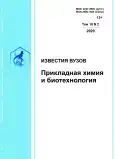On aggregation in binary biopolymer systems
- Авторлар: Matveev Y.I.1, Averyanova E.V.2
-
Мекемелер:
- Emanuel Institute of Biochemical Physics, Russian Academy of Sciences
- Biysk Technological Institute (branch) of the Altay State Technical University
- Шығарылым: Том 10, № 2 (2020)
- Беттер: 223-231
- Бөлім: Physico-chemical biology
- URL: https://ogarev-online.ru/2227-2925/article/view/299677
- DOI: https://doi.org/10.21285/2227-2925-2020-10-2-223-231
- ID: 299677
Дәйексөз келтіру
Толық мәтін
Аннотация
Негізгі сөздер
Авторлар туралы
Yu. Matveev
Emanuel Institute of Biochemical Physics, Russian Academy of Sciences
Email: yu.matveev@mail.ru
E. Averyanova
Biysk Technological Institute (branch) of the Altay State Technical University
Email: lena@bti.secna.ru
Әдебиет тізімі
- Павлов М.Р., Николаев Е.В., Андреева Н.П., Барботько С.Л. К вопросу о методике оценки стойкости полимерных материалов к воздействию солнечного излучения (обзор) // Труды ВИАМ. 2016. N 7 (43). С. 98–112. https://doi.org/10.18577/2307-6046-2016-0-7-11-11. URL: http://viamworks.ru/plugins/content/journal/uploads/articles/pdf/987.pdf
- Tweeddale H.J., Hawkins C.L., Janmie J.F., Truscott R.J., Davies M.J. Cross-linking of lens crystallin proteins induced by tryptophan metabolites and metal ions: implications for cataract development // Free Radical Research. 2016. Vol. 50. Issue 10. P. 1116–1130. https://doi.org/10.1080/10715762.2016.1210802
- Королева И.А., Егоров А.Е. Метаболизм хрусталика: особенности и пути коррекции // РМЖ. Клиническая офтальмология. 2015. Т. 15. N 4. С. 191–195.
- Муранов К.О., Островский М.А. Молекулярная физиология и патология хрусталика глаза. М.: Торус Пресс, 2013. 295 с.
- Borzova V.A., Markossian K.A., Muranov K.O., Polyansky N.B., Kleymenov S.Yu., Kurganov B.I. Quantification of anti-aggregation activity of UV-irradiated alpha-crystallin // International Journal of Biological Macromolecules. 2015;73:84–91. https://doi.org/10.1016/j.ijbiomac.2014.10.060
- Bumagina Z.M., Gurvits B.Y., Artemova N.V., Muranov K.O., Yudin I.K., Kurganov B.I. Mechanism of suppression of dithiothreitolinduced aggregation of bovine alpha- lactalbumin by alpha-crystallin // Biophysical chemistry. 2010. Vol. 146. P. 108–117. https://doi.org/10.1016/j.bpc.2009.11.002
- Borzova V.A., Markossian K.A., Kurganov B.I. Relationship between the initial rate of protein aggregation and the lag period for amorphous aggregation // International Journal of Biological Macromolecules. 2014. Vol. 68. P. 144–150. https://doi.org/10.1016/j.ijbiomac.2014.04.046
- Глесстон С, Лейдлер К., Эйринг Г. Теория абсолютных скоростей реакций / пер. с англ. М.: Государственное издательство иностранной литературы, 1948. 584 с.
- Matveyev Y.I., Askadskii A.A. Additive scheme for determining the activation energy of low temperature transitions in polymers // Polymer Science U.S.S.R. 1991. Vol. 33. Issue 6. P. 1154–1161. https://doi.org/10.1016/0032-3950(91)90221-B
- Matveev Yu.I. Determination of the temperatures of transition into the state of viscous flow, denaturation, and the onset of intensive destruction of proteins with various structures // Polymer Science. Series A. 1997. Vol. 39. Issue 4. P. 476–484.
- Matveev Yu.I., Plashchina I.G. Effect of the degrees of polymerization of an enzyme and a substrate on the catalytic activity of the enzyme Polymer Science. Series A. 2012. Vol. 54. Issue 9. P. 718–723. https://doi.org/10.1134/S0965545X1208007X
- Matveev Y.I., Grinberg V.Y., Tolstoguzov V.B. The plasticizing effect of water on proteins, polysaccharides and their mixtures. Glassy state of biopolymers food and seeds // Food Hydrocolloid. 2000. Vol. 14. Issue 5. P. 425–437. https://doi.org/10.1016/S0268-005X(00)00020-5
- Колмогоров А.Н. К статистической теории кристаллизации металлов // Известия АН СССР. Серия математическая. 1937. Вып. 3. С. 355–359.
- Buera M.P., Roos Y., Levine H., Slade L., Corti H.R., Reid D.S., et al. State diagrams for improving processing and storage of foods, biological materials, and pharmaceuticals (IUPAC Technical Report) // Pure and Applied Chemistry. 2011. Vol. 83. Issue 8. P. 1567–1617.
- Чалых А.Е. Диффузия – метод исследования полимерных систем // Высокомолекулярные соединения. Серия С. 2001. Т. 43. N 12. С. 2304–2328.
Қосымша файлдар









